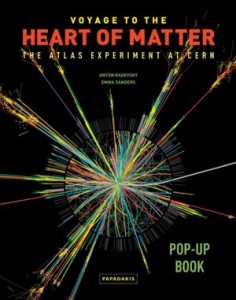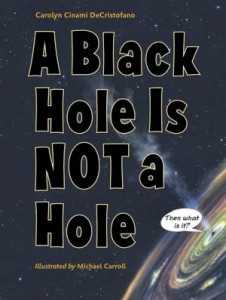 God particle, Higgs boson—it’s been news since Independence Day (no relation to said holiday) and most of us scratch our heads. It’s too hot to put our brains in gear! But discovery has a way of grinding on, whatever the season, and every time some big news in physics pops up, the religious skeptics pop up with it: take that, you believers! That gap where you like to keep your god keeps shrinking. As more and more phenomena are explained, there’s obviously less and less need to use some deity as an explanation, right?
God particle, Higgs boson—it’s been news since Independence Day (no relation to said holiday) and most of us scratch our heads. It’s too hot to put our brains in gear! But discovery has a way of grinding on, whatever the season, and every time some big news in physics pops up, the religious skeptics pop up with it: take that, you believers! That gap where you like to keep your god keeps shrinking. As more and more phenomena are explained, there’s obviously less and less need to use some deity as an explanation, right?
Actually, no. Science can answer the How questions to a certain point; it can chase speculation all the way to the edge of the universe, but can never get beyond it. Science can only study space and time, and any God worthy of the title is beyond space and time. New discoveries in no way disprove the old faith; they only shed light on how God created. Teasing apart the layers of phenomena we call “awesome” makes them no less awesome. In fact, I find the material universe all the more amazing (and God more praiseworthy) the more I find out about it. The secret we’re not supposed to know is that everyone, from Richard Dawkins to R. C. Sproul, from hardcore atheist to devout holy-roller, begins from a faith position, and there are only two faith positions: 1) the universe was created by an intelligent being, and 2) the universe created itself. Neither of those can be objectively proved, because one would have to step outside the universe to do it. Skeptics who say that science has disproved God don’t know what they’re talking about.
However, science gets tougher as we go along. Whether examining the incomprehensible vastness of space or the equally incomprehensible tininess of sub-atomic particles, the layperson has to absorb more and more data as a platform for understanding the next big discovery. It might seem equivalent to believing “six impossible things before breakfast,” like the White Queen in Through the Looking Glass. Whenever I want to take a stab at a difficult scientific concept (usually in physics) I head to the children’s section of my local library to browse the shelves. In today’s post I have a couple of book recommendation to save you the trouble, and a link or two.
But what about this God particle? (Feel free to skip this paragraph.) The name is a joke, derived from a book by Leon Lederman (2006); journalists love it and physicists don’t. The Higgs boson (a boson is a type of particle) doesn’t explain everything, but what it does is plug the last gap in the Standard Model of particle physics. To make a centuries-long story very short: since Newton’s time, physics has identified four major forces to account for all natural phenomena: gravitation, electromagnetism, and the strong and weak nuclear force. The grand goal, ever since the early 20th century, has been to break these down still further in order to discover the bedrock force that animates them all. In the 1960s, electromagnetism and the weak nuclear were linked into a single electroweak force, and the discovery of quarks redefined the strong nuclear force. Then the race was on to discover th e one missing but predicted particle that would explain the last riddle of the subatomic world, namely: How do certain massless particles acquire mass? Higgs is it. If further testing proves out, physicists will consider the Standard Model to be complete. Higgs doesn’t do a thing for gravity, though—we’re still pretty much clueless about how gravity actually works. A link between astrophysics and particle physics—the Grand Unified Field Theory—remains the Holy Grail of science. Reason to Believe has a 30-minute podcast on the Higgs particle, and what it means for Christians, here.
e one missing but predicted particle that would explain the last riddle of the subatomic world, namely: How do certain massless particles acquire mass? Higgs is it. If further testing proves out, physicists will consider the Standard Model to be complete. Higgs doesn’t do a thing for gravity, though—we’re still pretty much clueless about how gravity actually works. A link between astrophysics and particle physics—the Grand Unified Field Theory—remains the Holy Grail of science. Reason to Believe has a 30-minute podcast on the Higgs particle, and what it means for Christians, here.
For youngsters and parents who are really interested in understanding what the Higgs fuss is all about, here’s a very cool-looking resource: a pop-up book about the Large Hadron Collider (LHC) in Geneva, where the Higgs was discovered. The book was published long before last week’s announcement, obviously, but it looks like a good introduction to how the collider works and what it’s used for. Since the LHC was built specifically to search for the Higgs boson, there should be some background about the Standard Model and the gap Higgs was supposed to fill. I say “should” because I haven’t had the book in my actual hands. I get most of my review copies from the library, and it’s unlikely that any library would invest in a book that begs for abuse from the resident toddler. Please note: just because it’s a pop-up book doesn’t mean it’s written for children. It’s probably more suitable for science-minded young teens and older. And it might be worth the price (about $25—less than dinner and a movie) (and even though we get a little bonus from Amazon for helping to sell their books for them, I found it a couple dollars cheaper on abebooks.com). For a preview, check out this Youtube video from Emma Sanders, co-author and LHC physicist.
As I mentioned, the micro world of particle physics so far has little connection with the macro world of deep space. But if your interest  leads to black holes and time tunnels, a new book by Carolyn DeChristofano might be just the thing. Stephen Hawking did a pretty good job of explaining the subject (not surprisingly, since he did a lot of the pioneering work on it), but for a slightly shorter, less-involved explanation it would be hard to beat A Black Hole Is Not a Hole. It conveys a lot of information fairly painlessly, helped by artist representations, false-colored NASA photos, diagrams and sidebars. The first six chapters bring you up to speed on what black holes are and how they are formed. Helpful summary pages give an overview of star types (classified by size, age, and brightness) and a field guide to black holes based on comparison of size and mass. Chapter 7 is speculation about actually entering a black hole (which we can’t). Chapter 8 backs up to Einstein and includes one of the best explanations of Einsteinian vs. Newtonian gravity I’ve ever read. It’s strictly neutral regarding origins and where all this awesomeness came from, so readers don’t have to deal with heavy-handed materialist philosophy. The publisher rates the reading level for ages 8-12, but it’s a good place to start for any age.
leads to black holes and time tunnels, a new book by Carolyn DeChristofano might be just the thing. Stephen Hawking did a pretty good job of explaining the subject (not surprisingly, since he did a lot of the pioneering work on it), but for a slightly shorter, less-involved explanation it would be hard to beat A Black Hole Is Not a Hole. It conveys a lot of information fairly painlessly, helped by artist representations, false-colored NASA photos, diagrams and sidebars. The first six chapters bring you up to speed on what black holes are and how they are formed. Helpful summary pages give an overview of star types (classified by size, age, and brightness) and a field guide to black holes based on comparison of size and mass. Chapter 7 is speculation about actually entering a black hole (which we can’t). Chapter 8 backs up to Einstein and includes one of the best explanations of Einsteinian vs. Newtonian gravity I’ve ever read. It’s strictly neutral regarding origins and where all this awesomeness came from, so readers don’t have to deal with heavy-handed materialist philosophy. The publisher rates the reading level for ages 8-12, but it’s a good place to start for any age.
- Worldview/moral value: N/A
- Literary value: 4 out of 5
Voyage to the Heart of Matter: the ATLAS Experiment at CERN, by Emma Sanders and Anton Redevsky. Papadakis, 2010, 8 pages. Age/interest level: 12-up.
A Black Hole is Not a Hole, by Carolyn Cinami DeChristofano. Charlesbridge, 2012, 71 pages. Age/interest level: 8-up.
We haven’t done too many reviews of science books yet, but it’s an oversight we hope to correct in the future. A distantly-related post might be Emily’s thoughts on evolution: Kids Books and the Historicity of Adam. Or see our reviews of books about really big numbers and the Chilean mine disaster. And there’s always the Poetry of Nature . . .
Support our writers and help keep Redeemed Reader ad-free by joining the Redeemed Reader Fellowship.
Stay Up to Date!
Get the information you need to make wise choices about books for your children and teens.
Our weekly newsletter includes our latest reviews, related links from around the web, a featured book list, book trivia, and more. We never sell your information. You may unsubscribe at any time.
We'd love to hear from you!
Our comments are now limited to our members (both Silver and Golden Key). Members, you just need to log in with your normal log-in credentials!
Not a member yet? You can join the Silver Key ($2.99/month) for a free 2-week trial. Cancel at any time. Find out more about membership here.
1 Comments
Leave a Comment
You must be logged in to post a comment.


Janie, I had no idea what a Higgs boson was, but it sounded like something to do with pig farming to me. After reading your post, I feel a lot more civilized.